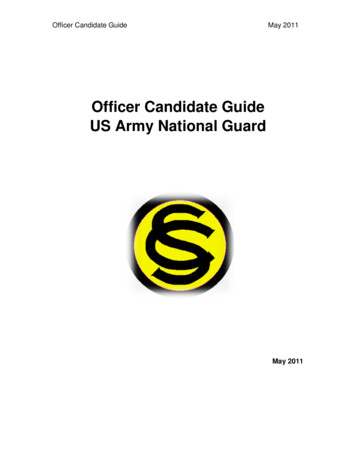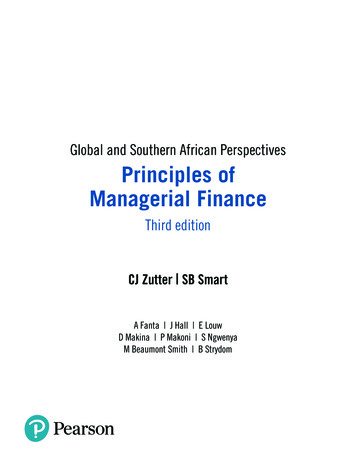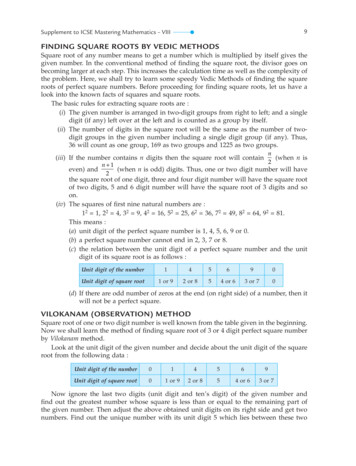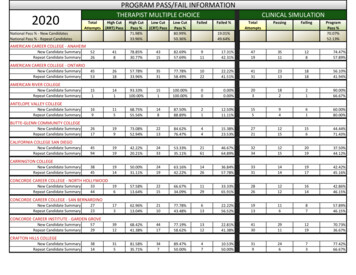
Transcription
Paper 7860-2016Finding and Evaluating Multiple Candidate Models for Logistic RegressionBruce LundMagnify Analytic Solutions, a Division of Marketing Associates, LLCDetroit MI, Wilmington DE, and Charlotte NCABSTRACTLogistic regression models are commonly used in direct marketing and consumer finance applications. Inthis context the paper discusses two topics about the fitting and evaluation of logistic regression models.Topic #1 is a comparison of two methods for finding multiple candidate models. The first method is thefamiliar “best subsets” approach. Then best subsets is compared to a proposed new method based oncombining models produced by backward and forward selection plus the predictors considered bybackward and forward. This second method uses HPLOGISTIC with selection of models by SBC(Schwarz Bayes). Topic #2 is a discussion of model evaluation statistics to measure predictive accuracyand goodness-of-fit in support of the choice of a final model. Base SAS and SAS/STAT are used.INTRODUCTIONThis paper focuses on fitting of binary logistic regression models for direct marketing, customerrelationship management, credit scoring, or other applications where (i) samples for modeling are large,(ii) there are many predictors, and (iii) the emphasis is on using the models to score future observations.There are two main topics:Topic 1: Finding a large number of promising candidate models for comparison and evaluationTwo methods are discussed:METHOD1: Best Subsets (SELECTION SCORE) of PROC LOGISTICMETHOD2: PROC HPLOGISTIC using METHOD BACKWARD and using METHOD FORWARD andcollecting the models that are created as predictors are either selected or consideredEither method can produce far more models than are needed for comparative evaluation on a validationdata set. To reduce the number of models to a manageable amount, the models are ranked by the1Schwarz Bayes criterion (SBC). The best 10 to 30 models might then be selected for evaluation.However, METHOD1 cannot handle a large number of nominal or discrete variables that would bedesignated as class variables. We provide a work-around, but this work-around has limitations.Topic 2: Evaluating the best candidate models on a validation data set and final model selectionASSUMPTIONS:It is assumed there is an abundant population from which to sample and that large sub-samples havebeen selected for the training, validation, and test data sets. It is also assumed that a large set ofpotential predictor variables X1 - XK have been given values as of an observation date. Finally, it isassumed that the target Y has been carefully defined and assigned a value of 0 or 1 where this value isdetermined by whether an event occurred within a specified time period following the observation date.SCHWARZ BAYES CRITERIONIn direct marketing, customer relationship management, or credit scoring (where there are large trainingdata sets and many candidate predictors) it is easy and tempting to over fit a logistic regression model. Itis natural to want to use all the information in the fitting of models that has been uncovered through datadiscovery. But the impact of using “all the data” in fitting a logistic model may be the creation of datamanagement overhead with either minimal or no benefit for out-of-sample prediction by the model.1In the case of Best Subsets the ranking is done by using a proxy for SBC.1
Of course, a purpose of a validation data set is to detect over-fitting. But a “penalized measure of fit” canhelp to detect over-fitting before proceeding to validation. A well-known penalized measure of fit for2logistic regression models is the Schwarz Bayes criterion (SBC). The formula is given below:SBC - 2 * LL log(n)* Kwhere LL is log likelihood of the logistic model, K is degrees of freedom in the model (including theintercept) and n is the sample size.The theory supporting the Schwarz Bayes criterion is complex, both conceptually and mathematically. Fora logistic modeling practitioner the primary practical consequence of the theory is that a model with3smaller SBC value is preferred over a model with a larger SBC value.PRE-MODELING DECISIONS AND DEGREES OF FREEDOMThe value of “K” (degrees of freedom in the model) for computing the SBC of a logistic regression modeldepends on decisions that the modeler makes before actual model fitting begins. Specifically, the modelerdecides how to transform a predictor X where this decision is based on a preliminary bivariate analysis ofX against the target Y. It is the use of the preliminary analysis that affects the degrees of freedom. In thisregard two topics are discussed in the following sections.1. The weight-of-evidence (WOE) transformation of a nominal or discrete predictor2. A non-linear transformation of a continuous predictor X, such as log(X)TRANSFORMING BY WOE AND DEGREES OF FREEDOMA character or numeric predictor C with L levels (distinct values) can be entered into a logistic regression4model with a CLASS statement or as a collection of dummy variables. Typically, L is 15 or less.PROC LOGISTIC; CLASS C; MODEL Y C and other predictors ;orPROC LOGISTIC; MODEL Y C dum k where k 1 to L-1 and other predictors ;These two models produce exactly the same probabilities.An alternative to CLASS / DUMMY coding of C is the weight-of-evidence (WOE) transformation of C.For the predictor C and target Y of TABLE 1 the weight-of-evidence transformation (or recoding) of C isgiven by the right-most column in the table.TABLE 1 – WEIGHT OF EVIDENCE TRANSFORMATION OF CCY 0“Bk”Y 1“Gk”Col % Y 0“bk”Col % Y 1“gk”WOE 50-0.693150.000000.18232The formula for the transformation is: If C “Ck” then C woe log(gk / bk) for k 1 to L where gk, bk 0.WOE coding is preceded by binning (or coarse classing) of the levels of predictor C. A discussion ofbinning is given by Finlay (2010 p. 146). A SAS macro for binning is given in Lund and Brotherton (2013).WOE Coding vs. CLASS / DUMMY CodingIf C is the only predictor in a logistic regression model, then the same probabilities are produced by thetwo models: (i) the WOE transformed predictor, and (ii) the CLASS / DUMMY coding.2SBC is also called BIC (Bayes Information Criterion). “BIC” appears in PROC HPLOGISTIC output.An introductory discussion of “Information Criteria” (SBC, AIC, and more) is given by Dziak, et al. (2012).4“CLASS C;” creates a coefficient in the model for each of L-1 of the L levels. The modeler’s choice of “referencethlevel coding” determines how the L level enters into the calculation of the model scores. See SAS/STAT(R) 14.1User's Guide (2015), LOGISTIC procedure, CLASS statement.32
Now other predictors X1 – XK are added to form the models (A) and (B):Model A: PROC LOGISTIC; CLASS C; MODEL Y C X1 - XK;Model B: PROC LOGISTIC; MODEL Y C woe X1 - XK;In this case: Models (A) and (B) produce different probabilitiesModel (A) has greater log-likelihood (better fit).Model (A) has better fit because the L-1 coefficients for C allow for greater interaction (real or spurious)5with other predictors in the logistic regression model than does the single coefficient for C woe.See Appendix A for several examples.Despite the short-fall in fit of WOE transformations, the choice of using WOE vs. CLASS / DUMMY is nota pivotal decision in enabling the building of good logistic regression models. The pros and cons of thetwo choices are discussed by Finlay (2010, pp. 155-159) and Thomas (2009, pp. 77-78). Siddiqirecommends the use of WOE coding for credit risk models where he shows how WOE coding naturallysupports score-card development. See Siddiqi (2006 pp. 91-92, 116).Degrees of Freedom for WOE Coded VariableA WOE predictor could not be assigned more degrees of freedom than the correspondingCLASS / DUMMY predictor since a WOE recoding produces a model with less fit. But should it have lessd.f. when considering the equality with CLASS / DUMMY coding in the case of the one-variable model?This leads to a working rule:If C has L levels, then its WOE transformation adds L-1 degrees of freedom to a model.Corrected degrees of freedom for a WOE coded predictor must be taken into account when computingSchwarz Bayes criterion (SBC) of a logistic regression model. This is especially a requirement when SBCis used to rank multiple candidate models and this ranking is used to eliminate low-ranked models from6further study. Generally, the working rule will over-penalize (inflate SBC) in the case of WOE predictors.TRANSFORMATIONS OF CONTINUOUS PREDICTORS AND THE DEGREES OF FREEDOMOften a modeler performs a preliminary bivariate analysis of a continuous predictor X against thetarget variable Y. This analysis may lead to the selection of a transformation for predictor X, such as“log(X)”, to be used when fitting the logistic regression model.A question arises: If log(X) is selected by this preliminary analysis and entered into a logistic regressionmodel, are 2 degrees of freedom being used (one for the coefficient and one for the choice oftransformation)?I think the answer is “yes” and this “yes” answer affects the number of degrees of freedom when7computing the Schwarz Bayes criterion (SBC) of a logistic regression model. However, in SAS programswhich are presented in this paper, the user will have a choice of making or not making this adjustment.MULTIPLE PROMISING CANDIDATE MODELS FOR COMPARISON AND EVALUATIONThe building of a logistic regression model is often an iterative process of fitting models and looking at theresults. It is better to replace the iterative process with an automated and structured process.5I believe the log-likelihoods of models (A) and (B) are equal if C woe is uncorrelated with each of X1 to XK.Since LL for models with WOE predictors (vs. CLASS) can be less, is there a general rule for assigning fewer thanL-1 d.f. to WOE’s. The question is content dependent and cannot be answered without knowledge of other predictorspin the model. Perhaps a heuristic formula might be developed of the following form: d.f. 1 (L-2) where L 1 and0 p 1 and the exponent “p” somehow depends on the count of predictors in the model. A further complexrefinement to the formula might somehow involve the variance inflation factor (VIF) of a WOE predictor. Developmentand implementation of a VIF refinement would be a challenge.7The degrees of freedom question is discussed in a survey article by Babyak (2004, see p. 417).63
A strategy for automated, structured model development involves these two steps:Step 1: Use an automated process to find “M” promising candidate models where M might be between 10and 30. These models are found by modeling on the training data set.Step 2: Use a structured evaluation of these M models on the validation data set with regard to:(i) parsimonious fit, (ii) goodness-of-fit, (iii) predictive accuracy, and, (iv) more subjectively,satisfying business requirements.Following Steps 1 and 2, the “final” model is selected and a final measure of performance of this model ismade on the test data set. The following section of the paper addresses Step 1.Two automated processes for finding multiple candidate models are presented next.METHOD 1: PROC LOGISTIC USING BEST SUBSETS AND PENALIZED SCORE CHI-SQUARE8The Best Subsets method of finding multiple candidate models is realized by using PROC LOGISTIC withSELECTION option “SCORE”. SCORE has 3 options: START, STOP, BEST.PROC LOGISTIC; MODEL Y X’s / SELECTION SCORE START s1 STOP s2 BEST b;The SELECTION options “START” and “STOP” restrict the models to be considered to those where thenumber of predictors is between s1 and s2. Then for each k in [s1, s2] the option “BEST” will produce the9b “best” models having k predictors. These b “best” models are the ones with highest score chi-square.The score chi-square is reported by PROC LOGISTIC in the report “Testing Global Null Hypothesis:BETA 0”.
Magnify Analytic Solutions, a Division of Marketing Associates, LLC Detroit MI, Wilmington DE, and Charlotte NC ABSTRACT Logistic regression models are commonly used in direct marketing and consumer finance applications. In this context the paper discusses two topics about the fitting and evaluation of logistic regression models.
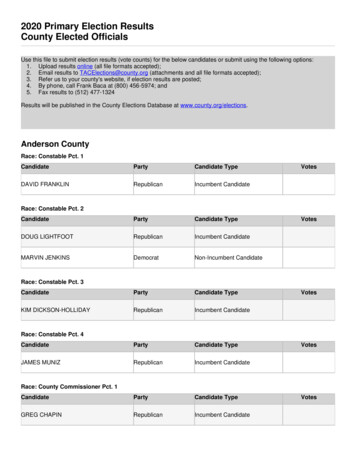

![OPTN Policies Effective as of April 28 2022 [9.9A]](/img/32/optn-policies.jpg)


